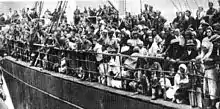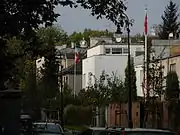Iran–Poland relations
Iran–Poland relations are historical and bilateral relationship between the Islamic Republic of Iran and the Republic of Poland. Both nations are members of the United Nations.
 | |
Iran |
Poland |
|---|---|
History

In 1474 Venetian merchant Ambrogio Contarini, delivered a letter to the Polish King Casimir IV Jagiellon from Shah Uzun Hasan.[1] As early as the 1500s, Iranian merchants and trading caravans entered into Europe, made contact and exchanged goods with Polish merchants.[2] In the following centuries Iran (known to the Europeans as Persia at the time) and Poland enjoyed friendly relations. The first documented visit of a Polish envoy to Iran took place in 1602.[3] Poland's victory over the invading Ottoman Empire at the Battle of Vienna in 1683 was celebrated in Safavid Iran.[4] After the victory, Polish King John III Sobieski was granted the proud title El Ghazi by the Persians,[5] and Shah Suleiman of Persia even contemplated a move to recover Baghdad, previously lost to the Ottoman Empire, however, he eventually abandoned the plan.[4] In 1795, Iran was one of two countries (the other being the Ottoman Empire) to not recognize the Partition of Poland by the Austrian Empire, Prussia and the Russian Empire.[1] After the partitions and following unsuccessful Polish uprisings, many Polish refugees fled to Iran. Among notable Poles living in 19th-century Iran were poet Aleksander Chodźko, Ignacy Pietraszewski, who translated the Zoroastrian Avesta into Polish,[3] and Izydor Borowski, former participant of the Polish Kościuszko Uprising and member of the Polish Legions, who was instrumental in modernizing the Iranian army, and eventually became a general in Iran.[6] Polish geologist Karol Bohdanowicz pioneered the geological survey of Iran's Khorasan Mountains.[3]

In 1918, after the end of World War I, Poland regained its independence. In 1919, Iran recognized Polish independence and both states established diplomatic relations.[7] In 1927, both nations signed a Friendship Treaty and in 1928, Poland opened a consulate in Tabriz.[7]
In September 1939, Poland was invaded by Germany and the Soviet Union, which sparked the beginning of World War II. In 1942, approximately 120,000 Polish refugees arrived to Iran.[8] The refugees were part of a larger exodus of between 320,000 to a million Polish evacuees who were forced out of Poland by the Soviet Union during the war and deported to the eastern parts of the Soviet Union and Siberia. With the assistance of Anders' Army, approximately 120,000 Polish evacuees left the Soviet Union to Iran where they awaited to emigrate to either the Australia, New Zealand, South Africa, United Kingdom, United States and elsewhere.[9] It was the largest migration of Europeans through Iran.[3]
In Tehran, the refugees were accommodated in four camps; including one of the private gardens of Iran's Shah; was transformed into a temporary refugee camp, and a special hospital was dedicated to them. After the war, a few even decided to stay in Iran permanently, marrying Iranian spouses and starting families.[8] Due to hunger and epidemics they suffered while held in Russia, over 2,800 Polish refugees died in Iran, and there are several Polish cemeteries located in various cities of Iran (Tehran, Bandar-e Anzali, Mashhad, Isfahan, Ahvaz).[3]
After World War II, Iran and Poland re-established diplomatic relations in August 1945. Their relations were elevated to embassies in 1962.[7]
In September 1966, Shah Mohammad Reza Pahlavi paid an official visit to Poland.[7] In May 1968, Chairman of the Polish Council of State, Marian Spychalski paid an official visit to Tehran. In 1979, Iran became an Islamic Republic after the Iranian Revolution. Relations between Iran and Poland continued uninterrupted ever since and several high-level visits have taken place between leaders of both nations.

However, in 2019, Poland hosted February Warsaw Conference in Warsaw, a conference which was believed to be anti-Iranian. This prompted angry reaction from the Government of Iran, which its state-run media ran a post condemning Poland and smearing them "fools in Warsaw", slammed Poland as mercenary of Washington.[10] Subsequently, Iran cancelled a Polish film festival which was about to take part in Tehran.[10]
High-level visits
High-level visits from Iran to Poland[7]
- Shah Mohammad Reza Pahlavi (1966, 1977)
- Prime Minister Amir-Abbas Hoveyda (1973)
- Prime Minister Mir-Hossein Mousavi (1989)
High-level visits from Poland to Iran[7]
- Chairman Marian Spychalski (1968)
- Prime Minister Piotr Jaroszewicz (1974)
- Prime Minister Leszek Miller (2003)
Bilateral agreements
Both nations have signed several bilateral agreements such as a Friendship Treaty (1927); Agreement on Trade (1952); Agreement on Road Transportation (1976); Agreement of Mutual Support and Protection of Investment (1998); Agreement on the Avoidance of Double Taxation (1998); Agreement on Air Transportation (1999) and an Agreement on Cooperation in the Field of Environmental Protection (2002).[2]
Trade
In 2017, trade between Iran and Poland totaled $230 million USD.[11] Iran's main exports to Poland include: Crude oil and oil products, petrochemicals, fruit, dried fruits (mainly pistachios and dried grapes) dates, plastics and plastic products, iron and steel, rugs and fitted carpets. Poland's main exports to Iran include: Agricultural machinery, food products, medical equipment and instruments, glass and home appliances.[2][11]
Resident diplomatic missions


See also
References
- History of Polish-Iranian relations
- Economic Relations between the Islamic Republic of Iran and the Republic of Poland
- "Iran - Poland in Iran". Portal Gov.pl. Retrieved 7 February 2021.
- Matthee, Rudi (2006). "IRAQ iv. RELATIONS IN THE SAFAVID PERIOD". Encyclopaedia Iranica (Vol. XIII, Fasc. 5 and Vol. XIII, Fasc. 6). pp. 556–560, 561.
- Hanna Widacka. "Bitwa pod Wiedniem – 12 IX 1683". Muzeum Pałacu Króla Jana III w Wilanowie (in Polish). Retrieved 7 February 2021.
- Utas, Bo (2002). "BOROWSKY, ISIDORE". Encyclopaedia Iranica.
- Kalendarium wydarzeń w relacjach polsko-irańskich (in Polish)
- The complex story of Polish refugees in Iran
- Forgotten Polish Exodus to Persia
- http://jcpa.org/fools-in-warsaw-iran-slams-poland-for-hosting-anti-iranian-conference/
- Iran, Poland take strides towards better economic cooperation
- Embassy of Iran in Warsaw
- Embassy of Poland in Tehran

